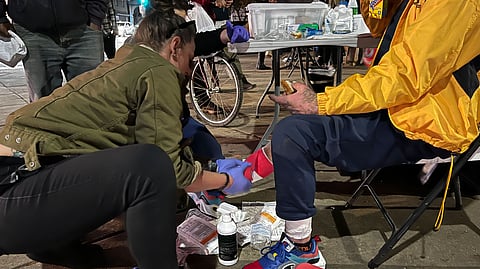By Courtenay Harris Bond
Many people living on the streets in Philadelphia’s Kensington neighborhood — the largest open-air drug market on the East Coast — are in full-blown addiction, openly snorting, smoking, or injecting illicit drugs, hunched over crates or on stoops. Syringes litter sidewalks, and the stench of urine fouls the air.
The neighborhood’s afflictions date to the early 1970s, when industry left and the drug trade took hold. With each new wave of drugs, the situation grows grimmer. Now, with the arrival of xylazine, a veterinary tranquilizer, new complications are burdening an already overtaxed system.
“It’s all hands on deck,” said Dave Malloy, a longtime Philadelphia social worker who does mobile outreach in Kensington and around the city.
Dealers are using xylazine, which is uncontrolled by the federal government and cheap, to cut fentanyl, a synthetic opioid up to 50 times stronger than heroin. The street name for xylazine is “tranq,” and fentanyl cut with xylazine is “tranq dope.” Mixed with the narcotic, xylazine amplifies and extends the high of fentanyl or heroin.
But it also has dire health effects: It leaves users with unhealing necrotic ulcers, because xylazine restricts blood flow through skin tissue. Also, since xylazine is a sedative rather than a narcotic, overdoses of tranq dope do not respond as well to the usual antidote — naloxone — which reverses the effects of only the latter.
Xylazine has been spreading across the country for at least a decade, according to the Drug Enforcement Administration, starting in the Northeast and then moving south and west. Plus, it has proven to be easy for offshore bad actors to manufacture, sell, and ship in large quantities, eventually getting it into the U.S., where it often circulates by express delivery.


